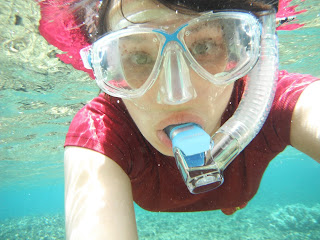Snorkeling in a plane, and other aquatic adventures
My first couple days on Pele were the weekend - no classes, nothing to do but adjust to village life and talk as much as I could in my broken Bislama. I think it was my second or third day, I was alternating between chatting, napping, and reading my Bislama textbook, and the day was starting to drag. "Hmmmm," I thought, "I remember this feeling. Just like last Peace Corps." But then - "Guess I'll go snorkeling!!!" My village, Launamoa, was right on the ocean. I swam at least once a day, and the snorkeling right in front of my house was pretty great. I saw all kinds of neat fish, including a group of clownfish hanging out around a rock covered in sea anemones. Some of my snorkeling adventures were farther afield, though. One time after lunch I complained about the heat to Terry, our language traininer. "Ok", he said, "Why don't we go swimming?" He guided us to a place where the reef drops off and the ocean gets deep - a totally new, neat experience.
On our final weekend on Pele, we went with Terry and his family to visit the site of a crashed World War II plane. (There wasn't any fighting here in Vanuatu to speak of, but there were bases here and pilots would fly to the Solomon Islands. The trip was far, and often they'd crash in the waters off of Vanuatu, running out of fuel before reaching their landing strip. In the case of the plane we visited, the pilot had been able to get out fine but the plane was lost). Getting there was quite an adventure. Our driver had to reverse the boat through a tiny channel through mangroves, everyone ducking to avoid being hit by branches. (After getting through the channel, we realized there was actually a much easier, wider route though them - but what's the fun in taking the easy route?)
We stopped at a tiny World War II museum with articles and artifacts, and then asked the woman manning the museum how to find the plane. The man who knew where it was had gone to town, she said. They had attached a buoy to it at one point, but someone had stolen the buoy - so we'd have to go look around ourselves. She did lend us two teenage girls who sort of had an idea of where to find it, but we were driving back and forth for a while, scanning the clear blue water for anything that looked like a plane on the bottom. At one point, as you do when you are lost, we "Pulled over and asked for directions." In our case, this meant asking a passing snorkeler - in Vanuatu many people snorkel to spear fish. He gave us rough directions - but how do you give clear directions about how to find something underwater?
I was the one who finally spotted it. It wasn't that deep under water - if you stood on the plane your head was out of the water, and it was easy to hold your breath, dive down, and explore or sit in the cockpit. The plane was now a habitat for plenty of fishes, and coral had colonized the tail. It was such a cool experience! Definitely a highlight of Peace Corps training. Vanuatu will be a challenge for sure, like any Peace Corps experience, but being here can sure be pretty awesome.
Not usually one for selfies, but I think this one is pretty cool!
The coral reef right near my house
Facing off with a clownfish
Terry hanging out at the bottom of the ocean
Our treacherous journey through the mangroves
We stopped at a tiny World War II museum with articles and artifacts, and then asked the woman manning the museum how to find the plane. The man who knew where it was had gone to town, she said. They had attached a buoy to it at one point, but someone had stolen the buoy - so we'd have to go look around ourselves. She did lend us two teenage girls who sort of had an idea of where to find it, but we were driving back and forth for a while, scanning the clear blue water for anything that looked like a plane on the bottom. At one point, as you do when you are lost, we "Pulled over and asked for directions." In our case, this meant asking a passing snorkeler - in Vanuatu many people snorkel to spear fish. He gave us rough directions - but how do you give clear directions about how to find something underwater?
The World War II Museum
Searching for the plane












That's incredible. It's interesting what remains from wars even if the locations didn't exactly see conflict, like the bunkers/causeway on Sitka.
ReplyDelete